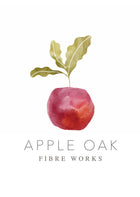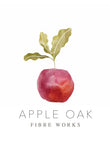You may also like

ALUM MORDANT (Potassium Aluminum Sulphate Dodecahydrate)
~ Necessary for most plant dyes to ensure colour fastness ~
Alum is considered the safest and least harmful mordant used in natural dyeing. It helps fix dyes to fibres and enhances colour retention. What many don't realise is that Alum occurs naturally in nature, and some plants, such as Lycopodium, contain natural Alum.
Mordanting Cellulose Fibres
For mordanting cellulose fibres, please refer to our blog for detailed recipes:
-
How to Mordant Linen and Cotton Fabrics Successfully – AppleOak FibreWorks
-
How to Mordant Linen and Cotton Successfully Without Tannins – AppleOak FibreWorks
Basic Recipe for Wool
Ingredients:
-
10%-20% Alum (based on the Dry Weight of Fibre - D.W.F.)
-
Wool (or other protein fibres)
-
Water
-
Optional: 5% Cream of Tartar (for hot mordanting)
Instructions:
Cold Mordanting:
-
Weigh your dry textile material.
-
Soak the dry material in water.
-
Dissolve Alum in hot water and add to a mordanting pot filled with water.
-
Add pre-soaked wool and let sit for 24-72 hours.
Hot Mordanting:
-
Dissolve Alum in hot water and add to a mordanting pot filled with water.
-
Add 5% Cream of Tartar to slow down the mordant uptake.
-
Add wool and bring to 80°C for 1 hour.
-
Let cool, then rinse and dye or dry for later use.
Alum is ideal for protein fibres like wool and silk, ensuring vibrant and lasting colour results.
Join The Natural Dyers & Growers Academy to share your experiences and receive support from fellow dyers!
Customer Reviews

Madder Dye – Cut or Ground
Rich Natural Reds for Dyeing | Wild-Harvested in Eastern Europe
Madder (Rubia tinctorum) is a renowned natural dye that produces a stunning range of reds—from warm oranges and rich brick reds to deep blood reds and fiery crimson tones. The final shade depends on multiple factors, including soil conditions, root age, mineral content of the water, dyeing temperature, and fibre-to-dye ratio.
Dyeing Tips:
- Mordanting: Avoid cream of tartar when mordanting cold.
- Soaking: Pre-soak fibres for at least 12h-24h before dyeing.
- Dyeing Methods: Madder can be used in both hot and cold dye baths. Adding chalk can help achieve better reds.
Colour Fastness: Excellent – Madder is known for its durability and deep, lasting hues.
Discover the beauty of natural dyeing with madder and create your own unique reds!
------------
Recipe for Wool: Downloadable PDF
Recipe for Plant fibres: Downloadable PDF
Also available as dye kit!
Madder Dye Kit for Plant Fibers: Available Here »
Madder Dye Kit for wool & Silk: Available Here »
Basic Madder Dye Recipe
(Adjust quantities as needed to achieve your desired shade. Water quality will influence colour result. Oranges instead of reds are often more likely)
Ingredients:
- 100g dried madder roots (soaked overnight and blended if possible, or use ground)
-
100g mordanted fiber (Alum-treated)
- Use 50g of fibre for darker reds or 300g for lighter shades
- 7–10 liters of water
- 6g calcium carbonate (chalk) (optional, for enhanced reds)
Instructions:
- Soak the madder roots in the dye pot overnight.
-
Gently heat to 65°C (149°F) and maintain for one hour for red tones.
- Higher temperatures will shift the colour towards brown.
- Strain the dye bath through a cloth to remove root particles.
- Add the mordanted fibre and the dye bag (optional, might result in uneven colour) back into the pot.
- Maintain a temperature between 65–95°C (149–203°F) for one hour to develop the colour.
IMPORTANT: The higher the temperature, the darker and browner the final shade.
Join The Natural Dyers & Growers Academy to share your experiences and get support from fellow growers.
Customer Reviews
OAK GALL
Use: Cellulose Fibre Mordant | Harvested From: Aleppo Oak in Turkey | Also Known As: Oak Apple | Recipe: link below
Oak Gall, also known as Oak Apple, is harvested from the Aleppo Oak in Turkey and is a traditional mordant used for cellulose fibres. Due to its high tannin content, it is an effective mordant for preparing cellulose-based fabrics for natural dyeing. Unlike other tannin-based mordants, Oak Gall only stains the cellulose fibre a light beige, making it a preferred choice for delicate dyeing projects.
Key Features:
- High tannin content for cellulose mordanting
- Minimal staining cellulose fibres
- Available whole, cut, or ground
Function:
Oak Gall is used to prepare cellulose fibres for natural dyeing, helping the dye adhere to the fabric without leaving stains. Its high tannin content ensures vibrant and durable colours on cellulose fabrics like cotton, linen, and hemp.
Storage & Usage:
- Available in whole, cut, or ground form.
- Store in a cool, dry place.
Perfect for natural dyers and textile artists working with cellulose fibre. Please see this recipe for mordanting cellulose with Gallotannin
Customer Reviews
SODA ASH ~ To change colour (PH indicator) and scouring cellulose fibres
No natural Dye Studio can do without Soda Ash. It may be used in small amounts to alter PH or used for scouring cellulose fibres. Soda Ash is alkaline and used to increase the PH in a dye bath as well as in an Indigo Vat. It also brightens yellows, especially Reseda and Sage.
Instructions:
In general Soda Ash can be dissolved in the hot dye bath at 3-10%. It helps to increase the PH of the bath.


Organic natural Indigo ~ Dye colour Blue
[our Indigo is NOT synthetic]
Country of Origin: India
The advantage in dyeing with Indigo is, that no mordant is needed. The water doesn't need to be heated to more than 40 degrees Celsius and a little goes a long way. We can dye 3-4 kg of Wool using 50g of Indigo.
There are many ways of dyeing with Indigo. Below you will find the recipe for a yeast vat. For a straight forward no-waiting-required approach, you can use Hydros as an oxygen remover. Waiting time approx. one hour.
Colourfastness: Excellent for dark colours, good for lighter colours
-------
Basic Recipe ~
It is possible to create a vat from indigo, lime (calcium hydroxide) and over-ripe fruit such as bananas or dates that relies on the chemistry of the sugars* rather than fermentation of the fruit. But it’s easier to simply use fructose shared in
Or for a more lightfast solution go for the recipe below or for a quick Vat, use the Hydros Vat, but it does use a chemical oxygen remover.
Both recipe are also available as dye Kits
FERMENTATION USING YEAST:
For 500gr wool etc. at one time . (amount can be repeated several times using the same bath)
9l water
dye container with lid
separate pot for the water bath to add the container
110gr sugar
50gr dried yeast with out preservatives etc.
30gr bicarbonate of soda
40gr ground Indigo
thermometer
This Method requires the dye bath to be on a constant 40 degrees Celsius and shouldn't exceed 50 degrees Celsius. Ideally put the dye pot in a water bath on a wire rack to ensure even distribution of temperature.
- Fill pot with 9l of water and heat to 40 degrees Celsius.
- Mix sugar and yeast and add to the water. Leave until dissolved and bubbly.
- Dissolve soda in a glass with hot water and add the dye, stir until smooth. Add to yeast mixture.
- Close lid and ideally put into a bin bag, you want it as air locked as possible. Leave at steady temperature for 8 hours.
- Lift lid and stir carefully until all the foamed Indigo has returned into the dye. Try to stir as little air into it as possible.
- Close the pot up again and leave for 48 hours until the water is yellow green.
- The water will show a metallic shimmer on the surface when ready. Carefully stir it back in.
- Add the damp but not mordanted wool etc. make sure all are under the water add a plate or a metallic disc to press the wool etc. under the surface. Whatever swims at the top will be unevenly dyed.
- Close it up and leave for 6 -12 hours.
- Remove wool etc. and press out back into the dye bath.
- Open wool etc. and leave exposed for at least 60min. All should turn blue.
- If you prefer a deeper blue add it to the dye bath again and repeat step 9.
- Wash twice with a mild soap, then rinse 4-5 times using vinegar in the last bath.
- Hang up and air for a few days or weeks.
You can repeat this dyeing process using the same dye bath several times.
Customer Reviews
IRON MORDANT ~ Mordant, Colour Changer, increased light fastness
Iron (Ferrous Sulfate) is used alone as a mordant, influencing Colours and to increase light fastness when used in combination with other natural dyes.
Iron is best known for shifting yellows into greens, keep in mind that this is not given and doesn't work with every yellow plant dye, in which case it will be more of a brown. it is used to increase light fastness for weaker plant dyes, bu it will always sadden and/or darken the colours.
---------------------------
Basic recipe:
When adding Iron to your dye bath start of with 3% and use it at the end of your dye bath or as an after bath. Allow to oxidize for 10 min for full colour development.
*If you like your colours darker, increase the Iron amount by 1-2% at a time.
**Leave for 10min than remove from dye bath - Iron will make wool brittle.



